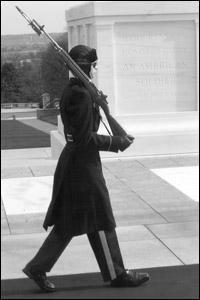Michael Steiner walks the mat at the Tomb of the Unknowns
recently. Steiner has completed 300 “walks.”
Corvallis man protects unknowns
By Wendy Geist
Gazette-Times reporter
Around 4.5 million people visit the Tomb of the Unknowns at Arlington National Cemetery near the nation’s capitol each year, and many come away talking about the incredible discipline and precision drill of the soldiers who guard the tomb 24 hours a day, 365 days a year.
No matter what the weather, the sentinels will be at their posts. The guards ritually march 21 steps south and then turn and march 21 steps north, repeating the process over and over again, all the while exhibiting a stony, emotionless face. Their sole purpose is to guard the unknown soldiers, and they give the impression of being utterly unaware of the onlookers.
Private First Class Michael Steiner of Corvallis is one of those men.
Steiner, age 20 and a 2002 Crescent Valley High School graduate, earned his tomb guard identification badge on Jan. 14 after nine months of rigorous training. He was the 536th person ever to be awarded the sterling silver badge. On Tuesday, Steiner will return to Arlington, where he will continue serving as an honor guard until September 2007.
He took time out Wednesday, on a short trip home to visit relatives and friends and to speak to seventh-graders at Franklin School about being a guard at the Tomb of the Unknowns. Students from the school will head to Washington, D.C., in March for a tour of the nation’s capital and hope to see Steiner in action while they are there.
The remains of unknown American soldiers from World Wars I and II and the Korean War are guarded out of respect and to “represent the American public in recognizing what these men sacrificed,” Steiner explained to the class.
Steiner joined the Army in Sept. 2003 because he wanted to fight in Iraq. He was assigned to the 3rd Infantry, a regiment steeped in tradition. Known as the Old Guard, the unit traces its beginnings to 1784 and does escort duty for military funerals at Arlington.
After three months with the Old Guard, during which he participated in burial processions at the cemetery, he was approached to become a sentinel at the Tomb of the Unknowns.
Though flattered, he became leery of the offer when he heard a little more about the training tomb soldiers go through.
“You work hard, and then they break you down,” he said.
Steiner had to pass a series of four tests in which he had to rewrite, word for word, 16 pages of information on the cemetery and the unknown soldiers. He also had to pass a one-hour timed test on his newly learned knowledge.
While in training, the soldiers are allowed to smile only in the kitchen and their bunker. If caught smiling elsewhere, they are forced to do push-ups. The trainees are also banned from watching television. Once they get their badge, though, the restrictions are loosened considerably.
Although he joined the Army to fight, Steiner said he is honored to serve as a sentinel and has never felt more accomplished than when he is guarding the Tomb of the Unknowns.
“To me it’s worth it. … It is the highest honor to be guarding those who gave their lives,” he said.
Steiner guards the tomb for one-hour shifts in the winter and half-hour shifts in the summer. He usually does two to three shifts a day and averages 10 days of guard duty a month at the tomb.
The discipline that goes into maintaining a sentinel’s uniform is almost unimaginable. Steiner spends four to six hours a day polishing and fixing up his leather shoes. He spends one and a half hours a day getting dressed.
There can be no wrinkles in his clothes, no smudges on the brass buttons, he explained to the class. Each element of his uniform must be aligned to within a 64th of an inch.
Steiner uses fine sandpaper to buff away any deficiencies in the layers of polish on his shoes. By the time he’s finished, the black leather gleams like obsidian.
“When we say perfection, we mean perfection,” he said.
Tomb guards in training are constantly being told they are wrong, Steiner said. Badge holders in charge of instructing the new sentinels physically reposition their bodies, pulling up their chins and locking up their knees, until the precise posture demanded of them becomes engrained in their memories.
During the changing of the honor guard, every motion is choreographed to the last detail, down to the number of steps and heel clicks and the exact sequence of the rifle movements.
“I can’t think of anything else in my life that has taken such commitment,” Steiner said. “This is definitely the most difficult thing I’ve ever done in my life.”
At Franklin, Steiner took a moment to instruct the students on their behavior while visiting the tomb.
“It is all about silence and respect,” Steiner told to class. There is no gum chewing allowed.
Michael Robert Patterson was born in Arlington and is the son of a former officer of the US Army. So it was no wonder that sooner or later his interests drew him to American history and especially to American military history. Many of his articles can be found on renowned portals like the New York Times, Washingtonpost or Wikipedia.
Reviewed by: Michael Howard

